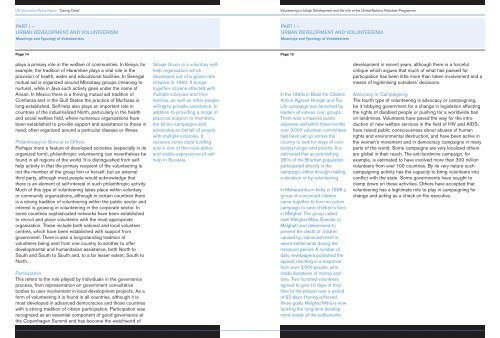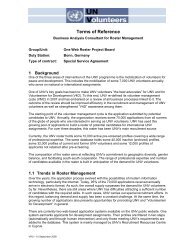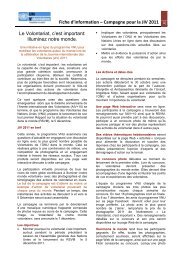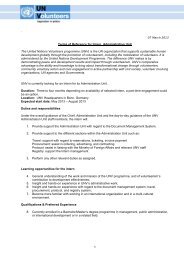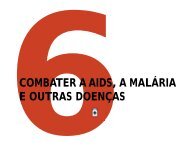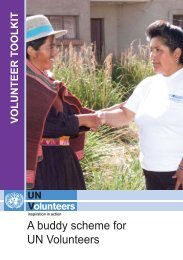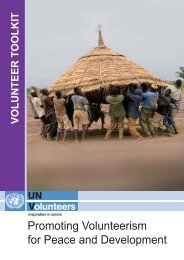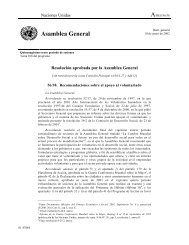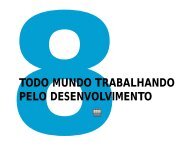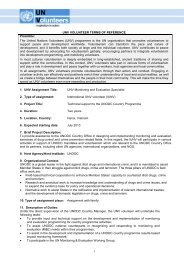View associated PDF document - United Nations Volunteers
View associated PDF document - United Nations Volunteers
View associated PDF document - United Nations Volunteers
You also want an ePaper? Increase the reach of your titles
YUMPU automatically turns print PDFs into web optimized ePapers that Google loves.
UN <strong>Volunteers</strong> Policy Paper<br />
‘Caring Cities’<br />
Volunteering in Urban Development and the role of the <strong>United</strong> <strong>Nations</strong> Volunteer Programme<br />
PART I –<br />
URBAN DEVELOPMENT AND VOLUNTEERISM<br />
Meanings and Typology of Volunteerism<br />
PART I –<br />
URBAN DEVELOPMENT AND VOLUNTEERISM<br />
Meanings and Typology of Volunteerism<br />
Page 14<br />
Page 15<br />
plays a primary role in the welfare of communities. In Kenya, for<br />
example, the tradition of Harambee plays a vital role in the<br />
provision of health, water and educational facilities. In Senegal<br />
mutual aid is organized around Mbootaay groups (meaning to<br />
nurture), while in Java such activity goes under the name of<br />
Arisan. In Mexico there is a thriving mutual aid tradition of<br />
Confianza and in the Gulf States the practice of Murfazaa is<br />
long-established. Self-help also plays an important role in<br />
countries of the industrialized North, particularly in the health<br />
and social welfare field, where numerous organizations have<br />
been established to provide support and assistance to those in<br />
need, often organized around a particular disease or illness.<br />
Philanthropy or Service to Others<br />
Perhaps more a feature of developed societies (especially in its<br />
organized form), philanthropic volunteering can nevertheless be<br />
found in all regions of the world. It is distinguished from selfhelp<br />
activity in that the primary recipient of the volunteering is<br />
not the member of the group him or herself, but an external<br />
third party, although most people would acknowledge that<br />
there is an element of self-interest in such philanthropic activity.<br />
Much of this type of volunteering takes place within voluntary<br />
or community organizations, although in certain countries there<br />
is a strong tradition of volunteering within the public sector and<br />
interest is growing in volunteering in the corporate sector. In<br />
some countries sophisticated networks have been established<br />
to recruit and place volunteers with the most appropriate<br />
organization. These include both national and local volunteer<br />
centres, which have been established with support from<br />
government. There is also a long-standing tradition of<br />
volunteers being sent from one country to another to offer<br />
developmental and humanitarian assistance, both North to<br />
South and South to South and, to a far lesser extent, South to<br />
North.<br />
Participation<br />
This refers to the role played by individuals in the governance<br />
process, from representation on government consultative<br />
bodies to user-involvement in local development projects. As a<br />
form of volunteering it is found in all countries, although it is<br />
most developed in advanced democracies and those countries<br />
with a strong tradition of citizen participation. Participation was<br />
recognized as an essential component of good governance at<br />
the Copenhagen Summit and has become the watchword of<br />
Slovak Union is a voluntary selfhelp<br />
organization which<br />
developed out of a grassroots<br />
initiative in 1990. It brings<br />
together citizens affected with<br />
multiple sclerosis and their<br />
families, as well as other people<br />
willing to provide assistance. In<br />
addition to providing a range of<br />
practical support to members,<br />
the Union campaigns and<br />
advocates on behalf of people<br />
with multiple sclerosis. It<br />
receives some state funding<br />
and is one of the most active<br />
and visible expressions of selfhelp<br />
in Slovakia.<br />
In the 1990s in Brazil the Citizens’<br />
Action Against Hunger and For<br />
Life campaign was launched by<br />
leaders of various civic groups.<br />
There was a massive public<br />
response and within three months<br />
over 3,000 volunteer committees<br />
had been set up across the<br />
country to look for ways of combating<br />
hunger and poverty. It is<br />
estimated that an astonishing<br />
38% of the Brazilian population<br />
participated directly in the<br />
campaign, either through making<br />
a donation or by volunteering.<br />
In Maharashtra in India in 1998 a<br />
group of concerned citizens<br />
came together to form an action<br />
campaign to save children’s lives<br />
in Melghat. The group called<br />
itself Melghat Mitra (Friends of<br />
Melghat) and determined to<br />
prevent the death of children<br />
caused by malnourishment in<br />
seven settlements during the<br />
monsoon period. A number of<br />
daily newspapers published the<br />
appeal, resulting in a response<br />
from over 3,000 people, who<br />
made donations of money and<br />
time. Two hundred volunteers<br />
agreed to give 10 days of their<br />
time to the project over a period<br />
of 92 days. Having achieved<br />
these goals Melghat Mitra is now<br />
tackling the long-term development<br />
needs of the settlements.<br />
development in recent years, although there is a forceful<br />
critique which argues that much of what has passed for<br />
participation has been little more than token involvement and a<br />
means of legitimising outsiders’ decisions.<br />
Advocacy or Campaigning<br />
The fourth type of volunteering is advocacy or campaigning,<br />
be it lobbying government for a change in legislation affecting<br />
the rights of disabled people or pushing for a worldwide ban<br />
on landmines. <strong>Volunteers</strong> have paved the way for the introduction<br />
of new welfare services in the field of HIV and AIDS,<br />
have raised public consciousness about abuses of human<br />
rights and environmental destruction, and have been active in<br />
the women’s movement and in democracy campaigns in many<br />
parts of the world. Some campaigns are very localized others<br />
are global in their reach. The anti-landmine campaign, for<br />
example, is estimated to have involved more than 300 million<br />
volunteers from over 100 countries. By its very nature such<br />
campaigning activity has the capacity to bring volunteers into<br />
conflict with the state. Some governments have sought to<br />
clamp down on these activities. Others have accepted that<br />
volunteering has a legitimate role to play in campaigning for<br />
change and acting as a check on the executive.


